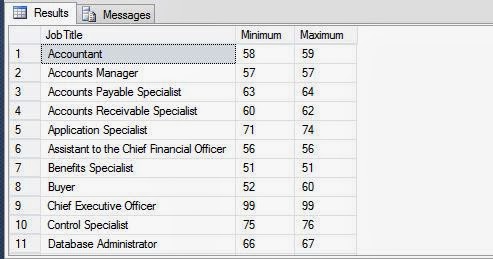At times, you need to view data matching specific criteria to be displayed together in the result set. For example, you want to view a list of all the employees with details of employees of each department displayed together.
Grouping can be performed by following clauses:
SELECT column_list
FROM table_name
WHERE condition
[GROUP BY [ALL] expression [, expression]
[HAVING search_condition]
Where,
SELECT JobTitle, Minimum = min (VacationHours), Maximum = max (VacationHours)
FROM HumanResources.Employee
WHERE VacationHours > 20 GROUP BY JobTitle
Outputs:
The GROUP BY ……..HAVING clause is same as the SELECT….WHERE clause. The result set produced with the GROUP BY clause eliminates all the records and values that do not meet the condition specified in the HAVING clause. The GROUP BY clause collects data that matches the condition, and summarizes it into an expression to produce a single value for each group. The HAVING clause eliminates all those groups that do not match the condition.
The following SQL query retrieves all the titles along with their average vacation hours when the vacation hours are more than 30 and the group average value is greater than 55:
SELECT Title, ‘Average Vacation Hours’ = avg (VacationHours) FROM HumanResources.Employee WHERE VacationHours > 30 GROUP BY Title HAVING avg (VacationHours) >55
The ALL keyword of the GROUP BY clause is used to display all groups, including those which are excluded by the WHERE clause. The ALL keyword is meaningful to those queries that contain the WHERE clause. If ALL is not used, the GROUP BY clause does not show the groups for which there are no matching rows. However, the GROUP BY ALL shows all rows, even if the groups have no rows meeting the search conditions.
The following SQL query retrieves the records for the employee titles that are eliminated in the WHERE condition:
SELECT Title, VacationHours = sum (VacationHours) FROM HumanResources.Employee WHERE Title IN (‘Recruiter’, ‘Stocker’,’Design Engineer’) GROUP BY ALL Title
Grouping can be performed by following clauses:
GROUP BY
The GROUP BY clause summarizes the result set into groups as defined in the query by using aggregate functions. The HAVING clause further restricts the result set to produce the data based on a condition. The syntax of the GROUP BY clause is:SELECT column_list
FROM table_name
WHERE condition
[GROUP BY [ALL] expression [, expression]
[HAVING search_condition]
Where,
- ALL is a keyword used to include those groups that do not meet the search condition.
- expression specifies the column name(s) or expression(s) on which the result set of the SELECT statement is to be grouped.
- search_condition is the conditional expression on which the result is to be produced.
SELECT JobTitle, Minimum = min (VacationHours), Maximum = max (VacationHours)
FROM HumanResources.Employee
WHERE VacationHours > 20 GROUP BY JobTitle
Outputs:
The GROUP BY ……..HAVING clause is same as the SELECT….WHERE clause. The result set produced with the GROUP BY clause eliminates all the records and values that do not meet the condition specified in the HAVING clause. The GROUP BY clause collects data that matches the condition, and summarizes it into an expression to produce a single value for each group. The HAVING clause eliminates all those groups that do not match the condition.
The following SQL query retrieves all the titles along with their average vacation hours when the vacation hours are more than 30 and the group average value is greater than 55:
SELECT Title, ‘Average Vacation Hours’ = avg (VacationHours) FROM HumanResources.Employee WHERE VacationHours > 30 GROUP BY Title HAVING avg (VacationHours) >55
The ALL keyword of the GROUP BY clause is used to display all groups, including those which are excluded by the WHERE clause. The ALL keyword is meaningful to those queries that contain the WHERE clause. If ALL is not used, the GROUP BY clause does not show the groups for which there are no matching rows. However, the GROUP BY ALL shows all rows, even if the groups have no rows meeting the search conditions.
The following SQL query retrieves the records for the employee titles that are eliminated in the WHERE condition:
SELECT Title, VacationHours = sum (VacationHours) FROM HumanResources.Employee WHERE Title IN (‘Recruiter’, ‘Stocker’,’Design Engineer’) GROUP BY ALL Title

